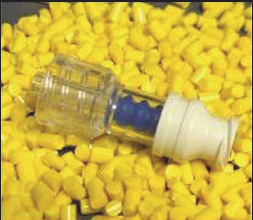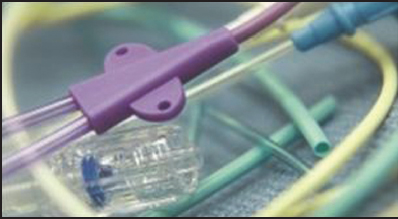|
Thermoplastic Polyurethanes: Enabling
Innovative Competitive Technologies Through Advanced Materials
|

Dr. Pallavi Kulkarni
Technical Manager
Lubrizol LifeSciences, U.S.A. |
Thermoplastic Polyurethanes (TPUs)
are a class of polymers with unique physicochemical properties. They are
inherently strong like thermoplastics yet flexible like elastomers, making
them the most versatile class of polymers. TPUs are composed of soft and
hard building blocks and the phase segregated morphology of these building
blocks imparts physical properties that cover the entire range of polymers
from soft, flexible elastomers to rigid engineered polymers and everything
in between. Additionally, the soft and hard blocks can be chemically chosen
such that they are biocompatible and biostable, suitable for medical
applications. TPUs are generally made from diisocyanates and diols. The
diols can either be of high molecular weight, known as a polyol, or low
molecular weight, known as a chain extender. The hard segment is comprised
of diisocyanate and chain extenders. The soft segment is predominantly
comprised of high molecular weight (~1000 Da – 3000 Da) diol. The hard or
high glass transition (Tg) segment gives the polymer its strength while the
soft or low glass transition segment imparts the material with flexibility.
The thermoplastic polyurethane references to polyurethane that can be
processed by common melt processing techniques such as extrusion to produce
film, sheet or tubing and injection molding for complex component
configurations. Thermoplastic polyurethanes can be classified in many
different categories based on the performance of the material which is
largely influenced by the building blocks used to produce the polymer. The
major categories include those defined by physical aspects, hardness, and
the chemical characteristics related to the diisocyanate and by the polyol
used to manufacture the polymers. The typical hardness range for TPUs is
from 70A elastomeric polymers to 85D engineered polymers. Softer TPUs
(50A-70A) are also commercially available. TPU hardness is generally
controlled by adjusting the hard and soft segments ratio. TPU’s are
generally plasticizer free but can be manufactured to include one if
necessary. |
 TPUs
are also referenced based on the nature of the soft segment or the polyol they
are based on, i.e. ether, ester and carbonate. The soft segment contributes the
flexibility to the TPU. Ester are known for their strength and oxidative
stability, ethers for low temperature performance and hydrolytic stability and
polycarbonates combine the oxidative stability and strength of the esters and
the hydrolytic stability of the ethers. Yet another way of referencing TPU’s is
by the type of diisocyanate being used, aliphatic or aromatic. A TPU comprising
of a polyether soft segment and an aromatic diisocyanate based hard segment is
referred to as “Aromatic Polyether TPU”. The chemical nature of the hard segment
also contributes to the overall strength and chemical resistance of the final
TPU. Aromatic TPUs are in general stronger and more chemical resistant than
their aliphatic versions. This difference can be largely attributed to the
ability of aromatic hard segments to organize and form crystalline domains. The
percentage crystallinity increases with increase in the hard segment content of
the TPU. Special considerations are needed to process TPUs with high
crystallinity. Screw design and temperature profiles need to be optimized so as
to ensure break down of these crystalline domains. TPUs
are also referenced based on the nature of the soft segment or the polyol they
are based on, i.e. ether, ester and carbonate. The soft segment contributes the
flexibility to the TPU. Ester are known for their strength and oxidative
stability, ethers for low temperature performance and hydrolytic stability and
polycarbonates combine the oxidative stability and strength of the esters and
the hydrolytic stability of the ethers. Yet another way of referencing TPU’s is
by the type of diisocyanate being used, aliphatic or aromatic. A TPU comprising
of a polyether soft segment and an aromatic diisocyanate based hard segment is
referred to as “Aromatic Polyether TPU”. The chemical nature of the hard segment
also contributes to the overall strength and chemical resistance of the final
TPU. Aromatic TPUs are in general stronger and more chemical resistant than
their aliphatic versions. This difference can be largely attributed to the
ability of aromatic hard segments to organize and form crystalline domains. The
percentage crystallinity increases with increase in the hard segment content of
the TPU. Special considerations are needed to process TPUs with high
crystallinity. Screw design and temperature profiles need to be optimized so as
to ensure break down of these crystalline domains.
TPUs can be processed into high precision tubing and
other medical components by techniques such as extrusion, injection molding or
dip casting. A key requirement before processing TPUs is to ensure that the
resin is dried thoroughly, below 0.02% moisture. TPUs are hygroscopic polymers
and can absorb up to 3% moisture under normal storage conditions. Moisture,
combined with heat while processing can lead to degradation and other undesired
characteristics such as air bubbles, rough surface and inconsistent dimensions
in the final product. Among various drying techniques available, desiccant
drying is the recommended method and is known to efficiently drive moisture from
within the pellets. Guidelines to effective screw design and other processing
considerations are largely dependent on the type of TPU, but generally do not
tend to vary a lot among different families.
 TPUs
have found wide spread application in medical devices primarily due to its
versatility in stiffness, chemical composition, processing and long history of
biocompatibility. Over the past several decades TPUs have found applications in
vascular, cardiac, neurovascular, urology, orthopedic and many other areas.
Selection of a particular grade of TPU is based on the area or region of
application inside or outside the body, duration of implantation, and the
desired physical properties. The differences in chemistries makes one type of
TPU suitable for a certain application but unsuitable for another. TPUs
have found wide spread application in medical devices primarily due to its
versatility in stiffness, chemical composition, processing and long history of
biocompatibility. Over the past several decades TPUs have found applications in
vascular, cardiac, neurovascular, urology, orthopedic and many other areas.
Selection of a particular grade of TPU is based on the area or region of
application inside or outside the body, duration of implantation, and the
desired physical properties. The differences in chemistries makes one type of
TPU suitable for a certain application but unsuitable for another.
Medical Device industry has grown exponentially in
the last decade with an evolving regulatory landscape. Device design engineers
are constantly looking to create the next-generation device with advanced
polymers and materials that offer an edge over existing materials. The
versatility and tailorability of thermoplastic polyurethanes has become an
essential tool in the design engineer’s toolbox. TPUs have successfully replaced
PVC for certain device applications where regulations prohibit the use of
plasticizers. PVC, although a well-established polymer has a contentious history
primarily due to disposal issues and extraction of plasticizers in to the body.
TPUs are plasticizer free and can be processed using the same equipment with
slight modifications in some cases. TPUs have a long history of biocompatibility
and biostability, which additionally provides justification for selection as an
alternative material. In some other instances, TPUs are being used instead of
silicones in next generation devices, thereby providing a competitive edge in
the marketplace. Major benefits of using TPUs is the ability to use smaller thin
walled tubing, higher flow rate and ability to introduce controls due to higher
sensitivity of TPUs. Yet another upcoming area of application for TPU is in drug
delivery. Ethylvinyl acetate (EVA) and silicones are the most widely used
polymers for drug delivery. However, they are limited in their properties and
the kind of drugs they can deliver. TPUs, due to their versatility, can be
modified to deliver hydrophobic and hydrophilic drugs and have the ability to
design the device either by matrix design or reservoir design. Additionally,
drug delivery devices can be manufactured by combining or segmenting different
TPUs to deliver both hydrophobic and hydrophilic drugs at the simultaneously in
a single device. TPUs soften when inserted in the body, which becomes a key
attribute for drug delivery devices like vaginal rings, where the ring needs to
be stiff prior to insertion and soften once inserted in the vaginal cavity for
patient comfort. The examples mentioned above showcase the uniqueness,
versatility and broad range of applicability of Thermoplastic Polyurethanes.
.
|

